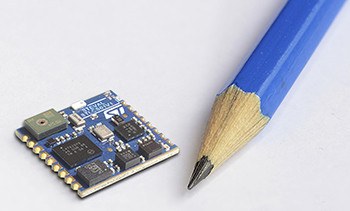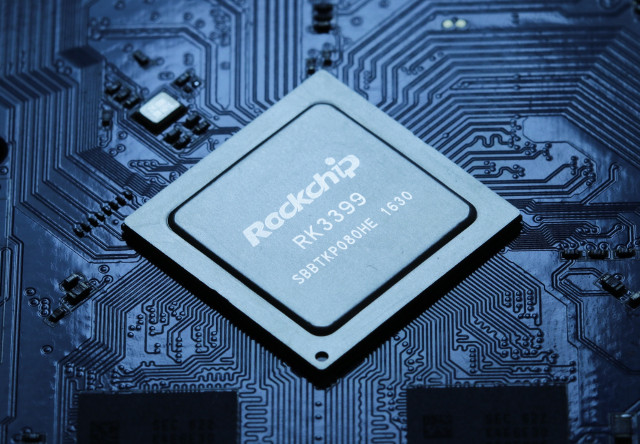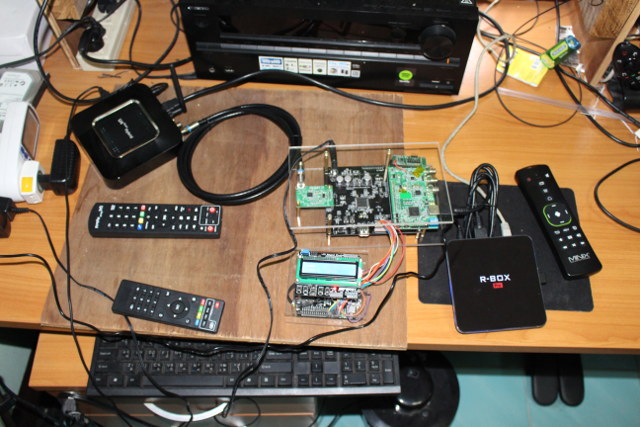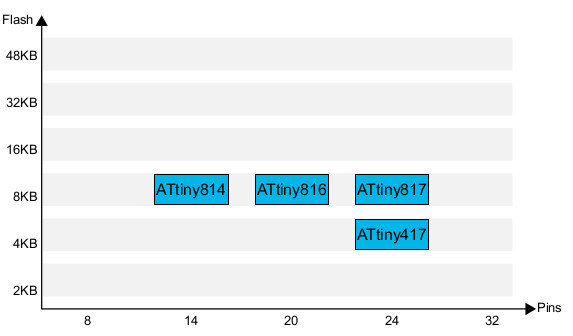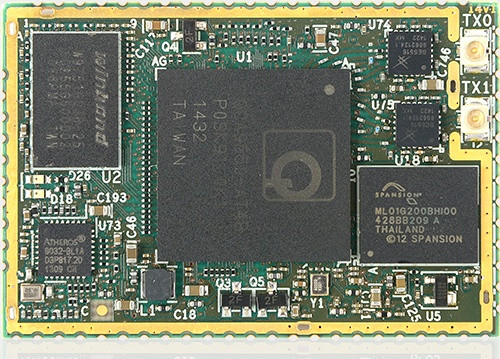STMicroelectronics SensorTile is a 13.5 x 13.5mm sensor board based on STM32L4 ARM Cortex-M4 microcontroller, a MEMS accelerometer, gyroscope, magnetometer, pressure sensor, a MEMS microphone, as well as a 2.4Ghz radio chip for Bluetooth 4.1 Low Energy connectivity for wearables, smart home, and IoT projects. SensorTile hardware specifications: MCU – STMicro STM32L476 ARM Cortex-M4 microcontroller@ up to 80 MHz with 128 KB RAM, 1MB flash Connectivity – Bluetooth 4.1 Smart/LE via BlueNRG-MS network processor with integrated 2.4GHz radio compliant with Sensors LSM6DSM 3D accelerometer + 3D gyroscope LSM303AGR 3D Magnetometer + 3D accelerometer LPS22HB pressure sensor/barometer MP34DT04 digital MEMS microphone I/Os – 2x 9 half holes with access to UART, SPI, SAI (Serial Audio Interface), I2C, DFSDM, USB, OTG, ADC, and GPIOs signals Debugging – SWD interface (multiplexed with GPIOs) Power Supply Range – 2V to 5.5 V Dimensions – 13.5 x 13.5 mm Software development can be done through […]
Grid-EYE Breakout Board is a $49 Low Resolution Thermal Camera Module
Thermal cameras can be really expensive pieces of equipment, and even the cheap 60×60 thermal cameras available on Aliexpress costs a little over $200. However, PURE Engineering has made an breakout board with Panasonic Grid-EYE infrared 8×8 array sensor that allows you to experiment with the technology, or integrate into your own projects for just $49. Grid-EYE breakout board features: Panasonic Grid-EYE AMG8834 64 pixel infrared / thermal camera sensor with 60 degree viewing angle using MEMS thermopile technology Pinout compatible with Arduino Zero, ST-NUCLEO board, and other 3.3V boards with I2C, VDD, GND, INT, and AD pins PUREModules PCB edge connectors with UART, GPIO, to interface with the company’s IoT board Power Supply – On-board regulator handles 3 to 5V input The Panasonic sensor transfers thermal presence, direction, and temperature values over I2C. The company wrote a demo for the module with an Arduino sketech and a Processing sketch […]
Theobroma Announces Rockchip RK3368 and RK3399 Qseven System-on-Modules
Theobroma Systems, an embedded system company based in Austria, has designed several Allwinner systems-on-module compliant with μQseven & Qseven standards in the past. The company has now started to work with Rockchip and reached “an advanced design stage” for the development of μQseven and QSeven systems-on-module powered by RK3368 and RK3399 processors. RK3368-uQ7 module specifications: SoC – Rockchip RK3368 octa-Core ARM Cortex-A53 processor up to 1.2GHz with Imagination Technologies PowerVR G6110 GPU System Memory – up to 4GB DDR3-1600 SDRAM on-module (512MB, 1GB, 2GB (default) and 4GB configuration available) Storage – Up to 128GB eMMC flash on-module (8GB default), 16 Mbit to 128 Mbit SPI NOR flash on-module Video Capabilities – H.264 decoding up to 2160p30, H.265 decoding up to 2160p60, video encoding up to 1080p30 Connectivity – GbE PHY on-module CAN – On-module communication offload controller for CAN 230-pin MXM edge connector with: 10/100/1000 Mbps Ethernet USB – 1x […]
A Closer Look at Ingenu RPMA Alternative to LoRa or Sigfox LPWAN Standards & RPMA Development Kit
I’ve recently started to write a bit more about long range LPWAN standards for IoT applications, especially LoRa and Sigfox, as commercial networks are being launched, and relatively low cost hardware platforms are being introduced to the market. There are also other highly expected standards such as Weightless and LTE Cat M that will bring more competition to the market. Ingenu RPMA (Random Phase Multiple Access) is another available standard that’s been in deployment for a while, and based on an earlier comparison of long range LPWAN standards, it comes with long range, supports up to 384,000 nodes per “sector”, operates in the unlicensed 2.4 GHz ISM band, and offers high combined uplink and downlink bandwidth than competitors. Ingenu recently contacted me and provided some more details and information about their technology and development kit. One of the documents includes an “independent analysis completed by ABI Research, Inc.” comparing features […]
V-Bridge Muses DTV Modulator and Video Encoder Review – Part 2: Muses-β Turnkey Solution Demo
V-Bridge Muses-α and Muses-β boards can be used to respectively broadcast video to DTV standard from your PC, and as a turnkey solution taking any HDMI, CVBS, or USB inputs. The VATek SoC used in those board support various DTV standards including DVB-T, DVB-C, ATSC/QAM, DTMB, ISDB-T/TB up to full HD resolution. I’ve received an early prototype for each, and I’ve already taken pictures and show how to assemble both Muses-α and Muses-β kits in the first part of the review. Today, I’ll show a demo with Muses-β turnkey solution taking HDMI input from an Android TV box (R-Box Pro), encoding and modulating the video to DVB-T, before broadcast it to an Android STB with a DVB-T/T2 tuner (U4 Quad Hybrid). This tool could be useful to test STB featuring ATSC or ISDB-T too, as those two standards are not supported in my country, and I could instead generate signals […]
Microchip Atmel ATtiny417/814/816/817 tinyAVR MCUs Include Core Independent Peripherals (CIPs)
Microchip’s latest Atmel tinyAVR MCUs combine Atmel 8-bit AVR core with CIPS (Core Independent Peripherals) normally found in the company’s PIC MCUs. Since Atmel’s purchase by Microchip, I believe this is the first time the company leverages features from both MCU families. The four new ATtiny MCUs come with 4 to 8 KB flash, and up to 24 pins: ATtiny417 – 8-bit Atmel AVR MCU with 4KB Flash, 256 bytes SRAM, 128 bytes EEPROM, 20MHz/20 MIPS, two 16-bit timer/counters, one 12-bit timer/counter, RTC, USART, SPI, Two-wire Interface (I2C), 10-bit ADC, 8-bit DAC, analog comparator, accurate internal oscillators and multiple calibrated voltage references, Custom Logic, 10-bytes unique ID, and 24 pins ATtiny814 – Same as above but with 8KB flash, 512 bytes SRAM, Peripheral Touch Controll (PTC), and 14 pins ATtiny816 – Same key features as ATtiny814 but with a 20-pin package with more I/Os ATtiny817 – Same key features as […]
8Devices Rambutan Qualcomm Atheros QCA9557 / QCA9550 GbE & WiFi Modules and Development Kit Run OpenWrt
8Devices, a Lithuanian company specialized in the development and manufacturing of electronic equipment, is known for their Carambola and Carambola2 WiFi modules powered by Ralink and Qualcomm Atheros WiSoCs. The company has now introduced a new dual band WiFi module called Rambutan that comes in commercial and industrial temperature range through respectively Qualcomm Atheros QCA9557 & QCA9550 SoCs. Rambutan and Rambutan-I modules specifications: SoC Rambutan – Qualcomm Atheros QCA9557 MIPS processor @ 720 MHz Rambutan-I – Qualcomm Atheros QCA9550 MIPS processor @ 720 MHz System Memory – 128 MB DDR2 Storage – 128 MB Flash Connectivity WiFi – 802.11 a/b/g/n, 2.4 or 5 GHz, 2×2 MIMO, 300 Mbps data rate, 21 dB per chain output power; 2x u.FL connectors Ethernet – Atheros AR8032 10/100M Ethernet PHY 68x half holes with 2 x USB 2.0 host port 2 x serial port 1x 100 Base-T Ethernet port; 1000 Base-T Ethernet port (SGMII […]
MUSES-α & MUSES-β DVB-T/C, ISDB-T, DTMB & ATSC Modulator Boards Review – Part 1: The Hardware
V-Bridge Muses digital TV modulator boards launched on Kickstarter earlier this month, with the cheaper $200 MUSES-α board modulating video from a PC, and $600 MUSES-β turnkey solution capable of broadcasting HDMI or AV + stereo input to various digital TV standards including DVB-T/C, ATSC/QAM, DTMB, and ISDB-T/TB without the help of a computer. The company sent me the two hardware kits for evaluation and review on CNX Software, and today I’ll start by showing off the hardware I received. I got 3 packages and a F-female to F-female cable, which means you can connect the board directly to your TV tuner without having to rely on actual RF signals, and potential legal issues that goes with it. The first package I open if for the PC modulator kit that include MUSES-α board, an “RF” board, as a USB cable to connect to your computer. MUSES-α board features Vatek A1 […]


